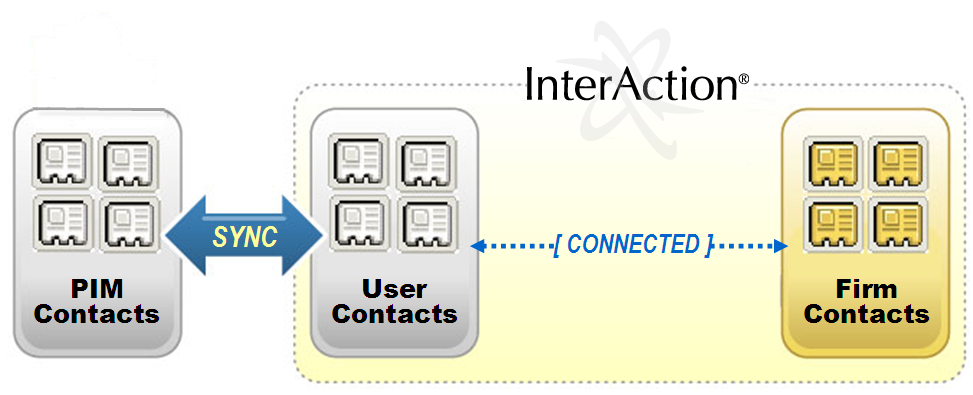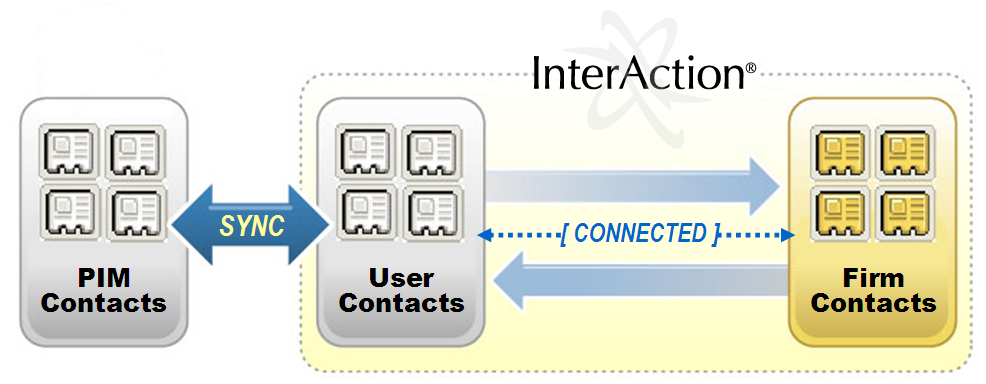Section Topics
The InterAction Solution
The key to InterAction’s CRM solution is that it parallels and enhances the way organizations do business. You and others at your organization are usually successful in managing your own view of your most important contacts. You track basic contact information in address books, contact management software, and/or handheld devices. If you provide good client service and are in touch with important contacts frequently, you can be confident that your information about these most frequently-contacted people and companies is current.
You are also aware that the organization maintains information about the same contacts. Marketing or business development groups usually have a database containing clients and prospects. Accounting maintains billing information about the organization’s clients. Other professionals may do business with the same clients and maintain their own information. The human resources or marketing department may track information about the internal people who work at the organization.
To accommodate the unique needs of these different groups of people, InterAction provides two interfaces for using the product:
- InterAction Web Client™
- InterAction Windows Client™
All professionals and assistants use the InterAction Web Client to maintain their own lists of contacts. Marketing, human resources, and other stewards of the organization’s various collections of information use the InterAction Windows Client to manage the organization’s collective knowledge about contacts that comes from the various other systems, users, and business processes. You can then access and leverage this managed Relationship Intelligence from the InterAction Web Client.
InterAction stores a Firm List of contacts, while you and all other users also have your own lists of contacts. The Firm List contains a single version of each contact. The same contact, however, may be in multiple user lists. Contacts in the Firm List are called Firm Contacts. Contacts in a user’s list are called user contacts. Note that your organization can customize the term for “Firm List.”
Note: The firm specifies the minimum required fields for any new contacts to be added to the system, whether to the Firm List or to User Lists. The minimum fields are also required for any contact to be shared from one list (e.g., user list) to another (firm list).
The following are some of the attributes of User contacts and Firm Contacts:
| User Contacts | Firm Contacts |
|---|---|
| Used by one person | Used by many people |
| Managed by an individual professional/assistant | Managed by a department |
| Contains private information, such as home phone numbers | Contains public information, such as business phone numbers |
In the example below, several users have the same contact, Joshua Smith, in their contact lists. Each has different information about Joshua. The Firm List contains a single version of Joshua Smith. It may contain some of the same information about Joshua as the various versions of Joshua in the user lists. The Firm Contact for Joshua may also contain unique information that is not contained in any of the user contact lists.

User Contacts and Firm Contacts
You can manage your contacts directly in InterAction. Alternatively, you can manage your contacts in a Personal Information Manager (PIM), such as Microsoft Outlook. InterAction synchronizes contacts in each user’s Outlook contact list with the contacts in the user’s InterAction contact list.
You can even use handheld devices such as iPhone, Android, and Blackberry devices to access and edit your contacts. You can then synchronize your handheld device with Outlook, which in turn can be synchronized with InterAction.
Although you maintain your own lists of contacts, you will want to be able to leverage the organization’s information for certain contacts. You will want to see information from other users (such as a new address for a contact) and be able to apply the information to your own list of contacts if appropriate. You may also want to contribute certain information about your contacts to the rest of the organization to ensure that the entire organization provides good service to their most important contacts. To facilitate this communication of information between the user lists and the Firm List, InterAction allows you to contribute [share] any of your contacts to the Firm List. This essentially “connects” the contact with the single version of the contact in the Firm List.

Connecting a User Contact to a Firm Contact
Connecting a user contact to a Firm Contact allows you to benefit from any updates made to the contact while at the same time retaining full control. You can choose to either accept updates automatically, or review them on a case by case basis.
You can also choose which information about the contact to keep confidential and which to contribute.

Updating Firm and User Contacts
You can set up rules for what information is confidential and what information is contributed.
In addition, connecting contacts can facilitate the following:
- Accessing the organization’s Relationship Intelligence for the contact
- Collecting the fact that you know the contact (Who Knows Whom information)
- Viewing alerts when other users make changes to the contact or record activities and appointments for the contact
- Adding the contact to mailing lists
For more about how you can manage your contacts in InterAction, see Overview of Contact Management.
For more about how you can take advantage of the InterAction database, see Overview of Leveraging Relationship Intelligence.
Example to Understand User and Firm Contacts
One way to understand InterAction is to think of your user list as your personal address book and the Firm List as a public phone book. You normally write just the information you care about in your address book. When you need to quickly look up the phone number of someone you know, you reach for your address book.
Sometimes, however, you need information that is not in your address book. Perhaps you need to look up a contact that you do not have in your address book. Or maybe you tried to call the number and found out that the number is no longer correct. In these cases, you typically pick up the public phone book for information. In the same manner, you can search the Firm List for information that you do not have in your user list.
